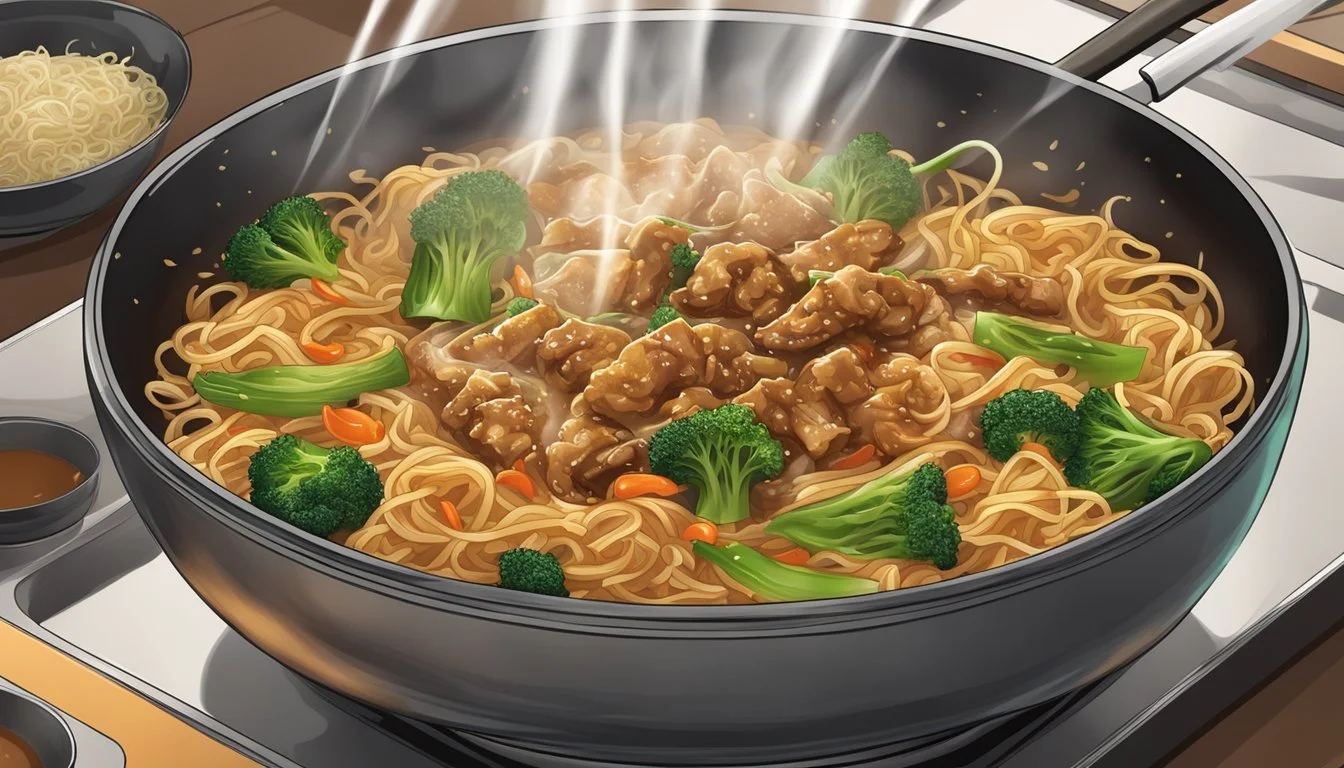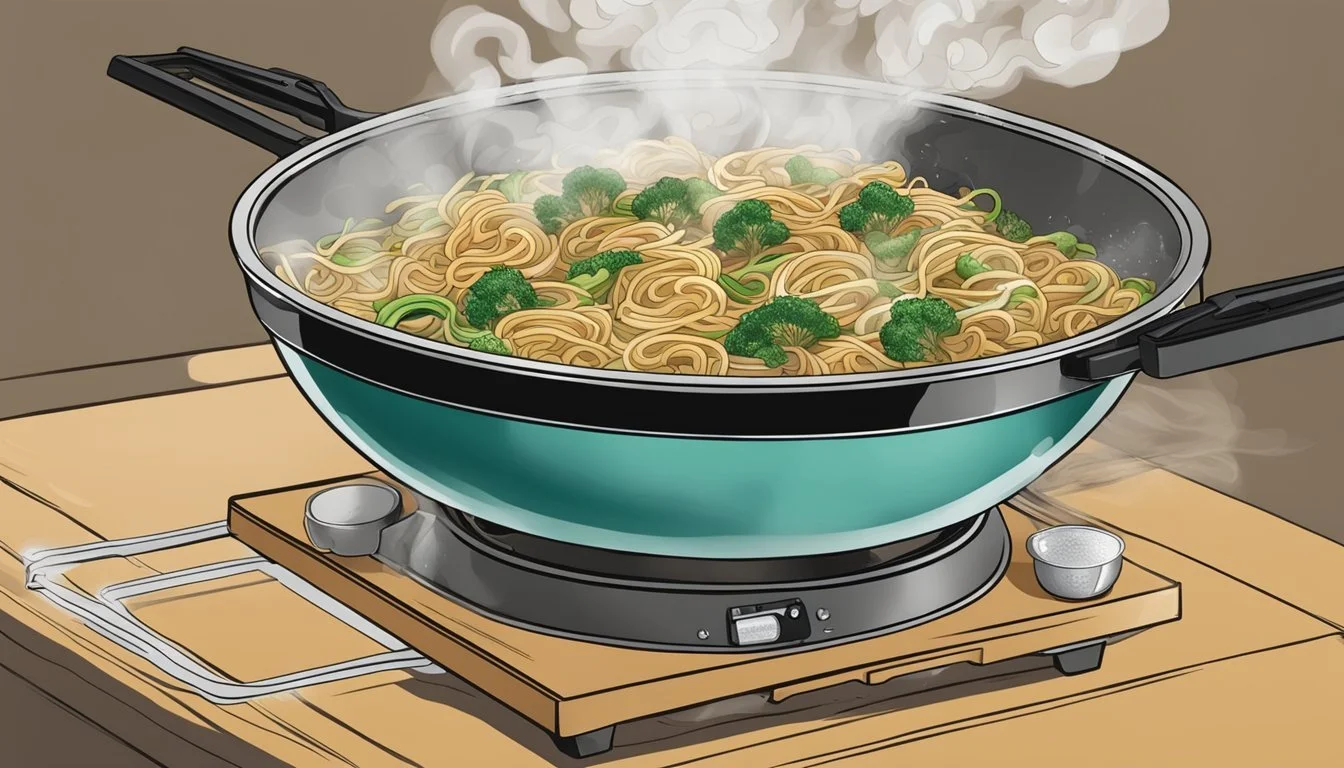Best Way to Reheat Pad See Ew
Prevent Noodles from Sticking
Pad See Ew, with its rich flavors and satisfying textures, stands out as one of the most beloved dishes in Thai cuisine. Cherished in Thai restaurants and revered as a staple of Thai street food, it seamlessly combines rice noodles with a variety of complementary ingredients, all wok-fried to create a dish that's both comforting and exciting to the palate. However, recreating that fresh-from-the-wok experience at home, especially when reheating leftovers, presents a unique challenge – keeping the noodles from sticking together without losing the dish’s signature texture and flavor.
To successfully reheat Pad See Ew without compromising its quality requires a delicate touch and the right technique. The key lies in gentle heat application and a little added moisture to ensure the noodles retain their distinct chewiness and do not clump. Whether using a stovetop or an oven, one must navigate the fine line between reheating the dish to an enjoyable warmth and preserving the integrity of its ingredients.
Having an understanding of the proper methods to revive leftover Pad See Ew is essential for anyone looking to enjoy this Thai favorite beyond their initial meal. It allows the dish to be appreciated in its full glory, embodying the essence of Thai food (What wine goes well with Thai food?) by delivering the perfect harmony of flavor and texture. With the right approach, one can breathe new life into their Pad See Ew, ensuring that it remains a delectable treasure of Thai cuisine, even on the second helping.
Understanding Pad See Ew
Pad See Ew is a Thai stir-fried noodle dish known for its unique flavor profile and texture. The dish is a perfect blend of tender proteins, chewy noodles, and a mix of savory sauces.
Components of Pad See Ew
Pad See Ew is comprised of wide rice noodles, a protein such as chicken, shrimp, or tofu, vegetables like gai lan, and a savory sauce with oyster sauce, dark soy sauce, and sweet soy sauce. Some chefs might add egg, lightly scrambling it with the noodles.
Characteristics of Rice Noodles
The rice noodles used in Pad See Ew are distinct for their chewy texture. These are wide noodles that, when stir-fried at high heat, achieve a slightly charred and smoky flavor while maintaining their structure.
Role of Ingredients in Flavor and Texture
Each ingredient in Pad See Ew plays a crucial role:
Proteins: Serve as the core, adding substance.
Vegetables: Like gai lan, add a touch of bitterness and crunch.
Sauces: A combination of oyster sauce, dark and sweet soy sauce create a balance between sweet and savory.
Pad See Ew vs. Pad Thai
Pad See Ew is often compared to Pad Thai, another popular Thai noodle dish. While both contain rice noodles and proteins like chicken or shrimp, Pad Thai is typically sweeter, with tamarind paste, fish sauce, lime juice, sugar, and garnished with peanuts and bean sprouts.
Storing Pad See Ew
Proper storage of Pad See Ew is essential to maintaining its quality. Leftovers should be placed in an airtight container and stored in the refrigerator. Properly labeling with the date can help track the shelf life, and if needed, Pad See Ew can also be frozen.
Reheating Challenges
When reheating Pad See Ew, it's important to avoid moisture loss which could result in the noodles sticking together. The goal is to restore the dish to its original flavor and texture without drying out the ingredients.
Preparatory Steps Before Reheating
Proper preparation is essential for ensuring Pad See Ew is reheated without the noodles sticking together. By taking a few simple steps before reheating, the dish can maintain its texture and flavor.
Bringing Leftovers to Room Temperature
Before reheating Pad See Ew, one should allow the dish to sit out of the refrigerator for about 30 minutes. Bringing the noodles to room temperature ensures a more even heat distribution during reheating and prevents the noodles from becoming too sticky.
Adding Additional Moisture
To prevent Pad See Ew from drying out and to help separate the noodles, one can add a small amount of moisture. Adding one to two tablespoons of water or oil to the dish can keep the noodles from sticking. If reheating in a microwave, oil can help retain the texture, while in an oven, water can create steam under a foil cover for moisture.
Selecting the Right Reheating Utensils
Choosing the proper utensils plays a pivotal role:
Microwave: Use a microwave-safe dish and cover with a vented lid or plastic wrap to trap steam.
Oven: Place Pad See Ew in an oven-safe dish, add water, and cover with aluminum foil to reheat evenly.
Stovetop: Heat a non-stick pan or a well-seasoned wok over medium heat. For smaller portions, a skillet might be more appropriate. If using an air fryer, place the Pad See Ew in the basket, ensuring it's not overcrowded to allow for air circulation.
Frying Pan: Always choose a non-stick frying pan to avoid sticking, or use a small amount of oil in a regular pan to create a non-stick layer.
Baking Sheet: Only recommended for an oven method if one can spread the noodles thin enough to heat quickly, usually after microwaving to loosen the noodles.
Reheating Methods and Techniques
To prevent noodles from sticking while reheating Pad See Ew, it's crucial to choose the right method and to apply heat evenly. Techniques vary by appliance, but each should be executed thoughtfully to maintain the meal's integrity.
Microwave Reheating
Using a microwave is a quick method to reheat Pad See Ew, but it should be done carefully to avoid clumping. Here's how:
Place the noodles in a microwave-safe dish.
Cover the dish with a paper towel to absorb excess moisture.
Heat on 50% power in one-minute increments, stirring between intervals for even heating.
Stove-Top Reheating
The stove offers excellent heat control and can resemble the original cooking method. To reheat on the stove:
Heat a non-stick pan on medium-high heat.
Add a small amount of oil to the pan to lubricate.
Add Pad See Ew and stir frequently for even reheating.
Oven-Based Reheating
The oven is effective for large quantities and can provide a gentle, even heat. To reheat using an oven:
Preheat the oven to 350°F (177°C).
Spread the noodles in a baking dish and sprinkle a bit of water to add moisture.
Cover with foil and bake until heated through, typically 10-15 minutes.
Using an Air Fryer
An air fryer offers a unique method that can restore the slight crispiness to the dish if done correctly. To reheat in an air fryer:
Place Pad See Ew in an air fryer basket, not overfilling to allow airflow.
Set the air fryer to a moderate temperature, around 350°F (177°C).
Reheat for a few minutes, checking periodically to prevent drying out.
Best Practices for Reheated Pad See Ew
Reheating Pad See Ew requires attention to detail to ensure that the noodles do not stick together and the dish maintains its tantalizing flavors and textures. The following sections outline specific methods to achieve the best results.
Ensuring Even Heating
For even heating, one should reheat Pad See Ew in a manner that distributes heat throughout the dish. Using a skillet over medium-high heat is optimal. Stirring the noodles gently will help distribute the heat more uniformly, preventing them from clumping together.
Heat a skillet on medium-high.
Stir gently for even heat distribution.
Retaining Texture and Flavor
To maintain the texture and flavor of Pad See Ew, a small amount of moisture may be added to the skillet to help steam the noodles, making them pliable yet preventing them from becoming soggy. It is important to not overcook to avoid the proteins and vegetables from losing their texture and becoming unappetizing.
Add a tablespoon of water or broth.
Heat until just warmed through, avoiding overcooking.
Adding Freshness with Garnishes
Garnishing reheated Pad See Ew can significantly enhance its appeal. Adding fresh elements such as lime wedges, crushed peanuts, and chopped herbs can revive the dish and add a layer of fresh flavors and textures.
Squeeze a fresh lime wedge over the dish.
Sprinkle with crushed peanuts and fresh herbs.
Serving Recommendations
Serve the reheated Pad See Ew immediately to preserve the quality of the dish. Pairing the Pad See Ew with a side of fresh vegetables can complement the textures and flavors. One might also consider a sprinkling of nuts for added crunch and flavor.
Serve immediately after reheating.
Accompany with fresh vegetables and a sprinkling of nuts for enhanced taste and texture.





